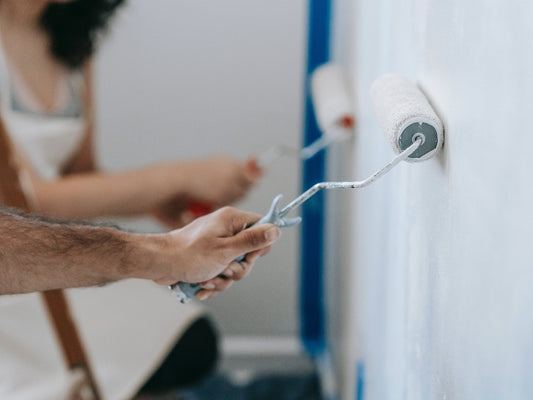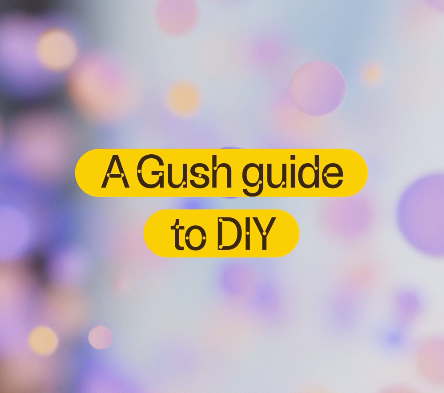Sustainability
Do paint brands live up to their promises? A guide on what to look out for.
Here at Gush, we’re passionate about science, wellness and ensuring full transparency for our customers. This article intends to equip readers with just enough knowledge to understand common paint claims, and verify them easily. At the end of the day, we all deserve to know what we put in our bodies, and that extends to our walls too.

Here at Gush, we’re passionate about science, wellness and ensuring full transparency for our customers. This article intends to equip readers with just enough knowledge to understand common paint claims, and verify them easily. At the end of the day, we all deserve to know what we put in our bodies, and that extends to our walls too.
Introduction
Welcome to the world of paint — where art meets science, meets construction. As with any business, marketing claims can be quite difficult to verify if you’re not an expert in the field. Recently, some of our supporters from the scientific community noticed how paint brands are increasingly making claims without scientific backing nor certifications.
Here at Gush, we’re passionate about science, wellness and ensuring full transparency for our customers. This article intends to equip readers with just enough knowledge to understand common paint claims, and verify them easily.
Non-toxic / VOC-free / Ultra low VOCs / Low VOCs

Historically, paint used to contain lead by default. Lead, a heavy metal, is extremely toxic and can lead to devastating health implications. Thankfully in 1978, lead was banned from paint products for interior use by the US congress. These days, we have more conversations about toxic levels, and make concerted efforts to purchase products that are safe — be it non-toxic, BPA-free, or phthalate-free.
When it comes to non-toxic paint, you’re looking for a formulation that releases as few Volatile Organic Compounds (VOCs) as possible. These are toxic gasses released in the air, and when inhaled, can cause mild to significant health problems. Words paint brands use:
- Low-VOCs
- Ultra Low-VOCs
- Zero VOCs
- Non-toxic
Of the lot, zero VOCs will be the strongest and most confident claim, while “non-toxic” needs some verification. The other options clearly show presence of VOCs. However, realistically, there is no such thing as zero VOCs in paint. When a product is labelled as such, it means it’s not formulated with any ingredients that contain or emit VOCs. Gush paints are formulated with the cleanest possible ingredients in paint formulation, and has been tested to show no detectable amount of VOCs*.
*Based on a instrument detection limit of 2g/L for Gush Care and 1g/L for Gush CleanCare — as conducted by TUV SUD and SETSCO respectively. Detection limit generally varies with the instrument or method of testing.
Odour

Closely linked to VOCs and toxic-levels, how one labels odour levels should tally with its VOC-label too. That’s simply because the odour comes from volatile chemicals. Some words paint brands use:
- Odour-less
- Low odour
- Zero odour
To put it simply, “zero odour” matches with “zero VOCs”. While “odour-less” means there is “less odour”.
Anti-mould

Especially in Singapore’s humid environment, the anti-mould feature is the number 1 thing we look out for. Anti-mould paints protect your walls from fungi attacks that could cause subsequent respiratory problems from mould spores lingering in the air. A good anti-mould paint ensures that you’ll never have mould issues in typical humid situations.

As per SS150 tests, painted samples are inoculated with mould, specifically Aspergillus niger, to test for its mould-resistance.
So how do you prove your anti-mould feature? Check for in-house tests, lab tests, and scientific data. At the very minimum, the SS150 compliance is a good starting point. Gush paints are SS150 compliant, and have been tested against many mould strains including:
- Apergillus niger
- Aspergillus flavus
- Trichoderma viride
- Aureobasidium pullulans
- Cladosporium herbarum
- Paecilomyces variotii
- Penicillium citrinum
- Alternata alternate

In this 21-day in-house test, we isolated a tile painted with Gush paint alongside bread exposed to mould. The results are astounding. While the bread crumbled from mould, the painted tile remained pristine, with no sign of mould growth.
Air-purifying

The newest feature on the paint market, air-purification is also the hardest to proof, considering there is no straightforward way to check the air quality in your home. This feature does not and should not claim to clean the air of dust, PM2.5 particles or anything beyond VOCs in the air.
How does air-purifying technology work, and how long can it last? Those are the questions that should be asked. If the paint uses bamboo, charcoal or anything of that nature — we have some bad news for you. Those materials absorb VOCs and store them within your walls. Which means there is a saturation point to this absorption, and VOCs could be re-released into your air when the temperature rises on a casual sunny afternoon.

At Gush, we are proudly transparent about our signature air-purifying paints. To put the science simply, our paints use chemical catalysts that never saturates. Catalysts helps the chemical process of breaking VOCs down, and once completed, resets itself and repeats 24/7, around the clock, to the limit of 5 - 8 years where paints generally just lose their efficacy due to wear and tear. Other paint brands fail to provide information about how their air-purifying feature works, making it difficult to understand how it works, or if it works at all.

This test report conducted by TUV SUD demonstrates the efficacy of Gush’s air-purifying function, namely the 99% reduction of formaldehyde levels in the air in just 21 hours.

To enlarge the image: pinch to zoom on mobile; right click and open image in new tab on desktop.
Check relevant certifications.
If brands have certifications, they tend to wear them like a badge of honour, and rightfully so. Certifications are costly, but they give everyone peace of mind that your products indeed do what you market them to do. When brands don’t flaunt their certifications, or gloss over them, that’s cause for concern. It could be that they simply don’t have them, or they have not renewed them.

Why Gush?

Our paints are made from love from the lab. We’re so proud of our formulation, we have a dedicated science section on our website where we talk more about the ingredients, benefits and chemical processes that goes into creating our paints in terms that are easy to understand. Our in-house R&D team works hard to for quality assurance, ensuring all our certifications are up to date, while always engaging in rigorous testing — from in-house, to collaborative, and 3rd party tests. We know our paints work, and we have the tests to prove it.
6 features, 1 tub, competitive pricing

At Gush, our flagship interior paints come in just 2 variants. Each variant is packed with 6 features in 1 — the only decision you’ll have to make is to choose between stain-resistance or humidity-control (and colours, of course). Other traditional paint brands come in multiple variants that can be difficult to understand. Decision paralysis is a big problem, that should be reserved for colour choices to bring your space to life. With all-inclusive features, our paints give you so much more, and at competitive prices too.
Conclusion
Marketing terms can be misleading or confusing, but knowing what they mean will help with making informed decisions. As a rule of thumb, transparency of information is always a green flag. When information is readily available for verification, you can rest easy knowing you’re purchasing a trusted product that does what it says.
That’s why at Gush, we’re dedicated to talking the talk and walking the walk — our paints have not only gone through rigorous testing, but we’ve done the legwork and gotten ourselves certified in Singapore and internationally too. All so you can rest easy knowing that you’re purchasing from a trusted paint brand that’s constantly testing and innovating. At the end of the day, we believe that humanity deserves better, and we should know what we put on our walls too.






